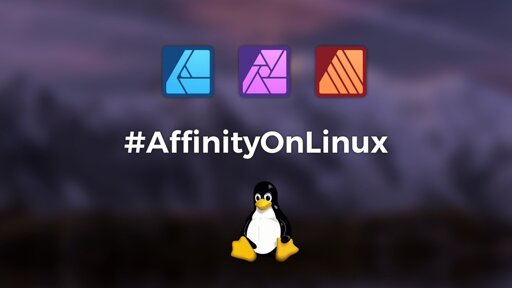Help support. Please make Affinity possible on Linux!
Why not just use and support fully open source alternatives like Krita, Inkscape, Kdenlive, etc instead of giving money to Adobe?
Affinity is not affiliated with Adobe. And presumably because Affinity is higher quality than it’s open source alternatives.
if youre fine with relying on proprietary software you might as well just run it in a windows 11 ltsc iot enterprise vm
It’s not just about quality, there’s a lot missing or honestly plain worse in gimp for example, compared to affinity photo. I’m as big a proponent of OSS as any, it’s just that software isn’t there yet.
What’s more, the target audience for that product are usually people who’ve had their chance encounter with programming and have decided against doing it. My anecdotal experience obviously. Edit: I mean it’s unlikely they will contribute to features
it’s just that software isn’t there yet.
I put about 2000 hours of work into $open_source_project. After a huge release 10xing the quality, we had about 1000x as many users.
The existing user base was ecstatic- for many of them, it was all they ever wanted and more. But we had 1000x new people saying “it just isn’t there yet”
That happens to the commercial folks too. It is just the nature of the adoption curve.
It is the same with price. A few will say that your product is already worth 10x the price. Most will say it’s too expensive. If you drop the price, a few more will see the value. Lots won’t.
More users is more users though. It is not something to get discouraged about. The advantage with Open Source is that, as long as it is useful to some, we have almost an infinite amount of time to expand it to new audiences. Baby steps pay off for Open Source.
Yeah, why help build the next “Adobe”? Use and donate to FOSS.
Yeah man. I don’t get it these days. Back when all we had was GIMP, I fully understood it. But switching to Krita has been pretty easy. The Photoshop binds are still a bit off, but nothing that you can’t go in and fix up the rest of the way
By the time they get feature parity I’ll be dead. Affinity is just plain better right now, and it’s not Adobe.
This isn’t Adobe.
And as much as I want to like Krita, GIMP and such, their workflows just can’t compare with proprietary software in many cases. Also, especially for photo editing, their feature sets can’t compare with Adobe’s or Affinity’s either.
I use Krita, GIMP and Affinity Photo pretty regularly, and while there have been great improvements to the open source alternatives recently, I just get stuff done with Affinity, while still having to constantly search the web for things Krita and GIMP hide somewhere deep within their menus.
All open source image editors I’ve used are in dire need of a complete UX rework (like Blender and Musescore successfully did) before being more than niche alternatives to proprietary software.
So, as of yet, I can definitely understand the wish for a feature-rich and easily usable image editing suite on Linux.
Blender did an amazing job with their overhaul. I really don’t know why anyone would use anything else for 3d modeling. I’m hoping they pump up their CAD features, but I understand if they don’t.
Idk, you lost me when you said Krita’s UI is too challenging… wtf
And that arrogant “I understand it, why don’t you?!”-attitude is exactly what’s so often the main issue in the design process of open source software.
I’d recommend watching this recent talk by Tantacrul, the design lead for MuseScore and Audacity. In it, he shows some videos of first-time user tests he conducted for Inkscape recently. It’s really fascinating to see, how users fail to do what they want because of confusing UX choices. And often it isn’t even that hard to fix. But open source image editors are just full of these little annoyances by now, which really smell like the result of inadequate user testing. And no professional would prefer to work all day with software full of little annoyances when there are alternatives.
I mean, just try adding text in Krita, for example. There’s a giant pop-up where you have to format your text without actually seeing it on your image. That’s just klunky and far more time consuming than a WYSIWYG approach would be.
@nyankas @HiddenLayer555 Unfortunately I have to agree, I find Photoshop hands down much easier and more intuitive to use than Gimp even though I’ve been using Gimp ever since Adobe went to a subscription only model because I absolutely refuse the Klaus Schwab notion of you will own nothing and be happy, bullshit. I was more than willing to pay for Adobe software when I could buy it but fuck if I will rent it.
The Affinity suite is not an Adobe product.
That is a waste of time. I emailed the company a few months ago and they replied that they won’t port to Linux. Not that they don’t have plans to currently do it, but that they won’t. Clear as day.
Indeed, I don’t get the post. Does OP genuinely think they could influence Affinity to support linux? Via freaking change.org?? Really, why is the post so well-received by community? Got so many questions.
FYI, Affinity was bought by Canva,
this is probably an advertising.Affinity will probably enshitify in the next release. Hopefully not, but who knows.I expect an affinity subscription plan.
i did not know that…
No problem. they are great currently.
Actually, I never witnessed change-org ever changed something.
Well it makes people feel like they’ve done something.
I’d rather support FOSS software
Yes, but if I wait for Gimp & Co. to become an alternative, I will be long retired or - most likely - dead.
So having Affinity on Linux would be fantastic for gfx professionals.
Are you doing profesionnal art/design work for a living ?
This is a Linux community not a professional art/design community.
…and some Linux users do professional art/design for living.
If you don’t start using and contributing to free tooling now, they’ll never get better and they’ll never be “professional” (whatever that actually means).
You can continue to lock yourself into proprietary tooling, but that result will always be the same: a decent product gets bought, made subscription, get worse in quality while bleeding the customer out via subscription. You are already there will Adobe, and its started for Affinity.
So, the longer you hold out on FOSS tooling, the worse and slower things will be.
Look at how excellent FOSS tools are when they get attention and investment: blender and krita.
is there anything more useless than signing online petitions?
Complaining about online petitions.
You can already use gimp and inkscape.
Also darktable, rawtherapee, DigiKam and Krita. Not sure if those are suited to professional work, but for amateurs they are more than enough.
The problem is that if widespread desktop Linux adoption is the goal, then the tools for amateurs aren’t going to cut it. Not even close. Tools that professionals use need to be available and they need to work like they do on macOS and Windows, it’s pretty much that simple. I think Darktable is fine for me tinkering around with my amateur photos. If I were a professional using it daily I’d probably hate it.
As much as we wish it wasn’t true, most people don’t really give a shit about their OS. It’s the logo that appears when they boot up their computers to work. What they do care about is having their tools available to them, if they can’t use the Adobe Suite, Pro Tools etc (and no, WINE is not a practical solution for most of these people) then Linux of any flavour is functionally useless to them. It’s for this reason that smug people saying “just switch to linux lol” as if it’s an actual solution whenever a Windows user complains about some rabidly anti-consumer bullshit that Microsoft is forcing onto them annoys the hell out of me.
It’s changing somewhat now, but it’s why you’ll find that a lot of people in the creative industries traditionally stick with macOS, because for a long time the options for those professionals were just better on that platform and people tend to stick with what they know.
On the other side of that coin, you have software vendors looking at the single-digit market share that Linux on the desktop “enjoys” and coming to the fairly reasonable conclusion that building packages, fixing bugs and providing support for myriad different distros just isn’t worth the headaches it will inevitably cause for them.
Classic chicken and egg problem.
Nah, they work great. The problem is just your generation.
If you learned the other tools first, you would say that adobe suite is clunky, difficult to use, and not suitable for professionals.
Gimp and inkscape both run fine on macOS and Windows.
I’m not really sure what assumptions you can reasonably make about me or my generation given that you have no idea who I am or how old I am, but I’ve been working with FOSS in my personal life for about 20 years give or take, a bit less than that in my professional life. I actually used to work in the music industry professionally before changing careers to tech with a FOSS slant during the pandemic, so I’ve seen both sides of this coin.
I’m genuinely not trying to shit on FOSS tools or say that they’re not suitable for creative professionals (my gripes with Darktable are very much personal to me), I love FOSS and the philosophy strongly aligns with my personal values but it’s not just about how “good” these tools are on an objective level. This is a cultural problem as much as it is an engineering problem, as you seem to have correctly identified.
You have to understand how ubiquitous something like Pro Tools suite is in the music industry and for how long that has been the case - the Pro Tools session format truly is a global industry standard by anyone’s measure. You can walk into just about any professional recording studio on the planet with your session files and the recording engineer will know exactly what to do with them, and so will mastering engineers and record producers. If you go to school for audio engineering, they’re teaching you Pro Tools. There are entire companies that produce outboard gear and control surfaces just for use with Pro Tools. You get the idea. The reason for that ubiquity is that Pro Tools, like many other creative software solutions, captured the market in the 90s when every other solution was an utter joke in comparison and they built on it from there. Sure, there’s fantastic alternatives now, but when you know Pro Tools like the back of your hand and so do all of your colleagues and collaborators, when all of your hardware and software works with it seamlessly… how likely are you to change?
I’m not suggesting that this isn’t a problem by the way - vendor lock-in is a serious bugbear of mine - but it’s a very real barrier to getting creative professionals to switch to FOSS alternatives, and in turn to getting software vendors to take FOSS platforms seriously. It’s a reality that cannot be hand-waved away by saying that x or y tool works great and that people just need to learn it and switch so that they can use Linux. If you can’t run Pro Tools on Linux, that’s a whole industry that won’t use it. It’s that simple.
Nah, the only reason those tools are used are because of momentum and the fact that most of their new hires have experience with it, also due to momentum.
Ban Photoshop from being taught in schools, and in two generations everyone will say that Photoshop is crap because it takes so long to do anything.
I kind of feel like you just ignored everything I wrote.
Yeah, you’re 100% correct. There’s also the issue of collaboration: it’s common to be given a Pro Tools or Photoshop file to continue work on.
Not to mention live show visual projection, where there isn’t anything in Linux even approaching the functionality of Resolume.
Linux is fantastic, but unfortunately most of us in this situation will need to keep a dual boot or another machine.
If you wan’t to use FOSS I get it, I want to. But when it comes to professionnal workflow you sometimes have to put your ego on the side. When I tried to ditch the Adobe Suite, the Free(dom) alternatives didn’t worked for me or the proprietary alternatives were simply better.
Inkscape is great but Affinity Designer is superior in many regards and even it is inferior to Adobe Illustrator. GIMP and Krita are awesome tools, honestly GIMP3 makes me want to play more with it and Krita is an awesome digital painting software, one of the best out there. But for photo editing Affinity Photo is still better for my workflow even if I still prefer to use Adobe Photoshop and Lightroom.
The new redesign of Scribus in unstable is exciting but I don’t see myself using it for professionnal work. Affinity Publisher is just better and yes again Adobe InDesign is still superior.
I’ve almost fully ditched Adobe (with the exception of Photoshop), I often try Free and Open Source alternatives and while some are good enough none can compare to Adobe who is leading the industry by the way, that’s the sad truth as of today.
Here is a list of alternative to Adobe I’ve made : https://alternativeto.net/lists/25812/softwares-for-content-creators-that-don-t-want-to-supports-adobe-monopole-/
Edit : grammar and typos
If you wan’t to use FOSS I get it, I want to. But when it comes to professionnal workflow you sometimes have to put your ego on the side. When I tried to ditch the Adobe Suite, the Free(dom) alternatives didn’t worked for me or the proprietary alternatives were simply better.
Then, I would argue, the alternative isn’t to sign petitions to make the corporate guys make their proprietary stuff available on FOSS operating systems. The alternative is to contribute to the FOSS alternatives in order to make them as good as the proprietary.
I’m not saying that you in particular haven’t contributed (either financially or developmentally). I don’t know you, so this isn’t particularly directed at you.
But in general, the “FOSS isn’t as good as proprietary stuff” crowd has overwhelmingly never actually tried to fund or contribute to the development of the software itself and their complaints amount to “Why isn’t my free thing as good as the thing they make me pay for?”
In which case the answer is “of course it isn’t…you’re telling me the software developed on the evenings and weekends by enthusiasts doing it in the spare time for NO money isn’t as polished as a fully funded business software!? NO WAY!!! I’M SHOOKETH!!!”
The alternative to the (perceived) quality disparity between FOSS and Proprietary isn’t to go begging at the Corporations doorstep; it’s to make the FOSS alternatives good enough to take the throne of “industry standard” away from the corporations.
It’s not impossible…hell, Blender is the poster child for pretty much doing exactly that. It’s not the “industry standard”, but it’s accepted in the industry in ways that GIMP and Inkscape still aren’t. And the reason is because it’s good enough to be there.











